Han Jiang
Speech Audio Generation from dynamic MRI via a Knowledge Enhanced Conditional Variational Autoencoder
Mar 09, 2025Abstract:Dynamic Magnetic Resonance Imaging (MRI) of the vocal tract has become an increasingly adopted imaging modality for speech motor studies. Beyond image signals, systematic data loss, noise pollution, and audio file corruption can occur due to the unpredictability of the MRI acquisition environment. In such cases, generating audio from images is critical for data recovery in both clinical and research applications. However, this remains challenging due to hardware constraints, acoustic interference, and data corruption. Existing solutions, such as denoising and multi-stage synthesis methods, face limitations in audio fidelity and generalizability. To address these challenges, we propose a Knowledge Enhanced Conditional Variational Autoencoder (KE-CVAE), a novel two-step "knowledge enhancement + variational inference" framework for generating speech audio signals from cine dynamic MRI sequences. This approach introduces two key innovations: (1) integration of unlabeled MRI data for knowledge enhancement, and (2) a variational inference architecture to improve generative modeling capacity. To the best of our knowledge, this is one of the first attempts at synthesizing speech audio directly from dynamic MRI video sequences. The proposed method was trained and evaluated on an open-source dynamic vocal tract MRI dataset recorded during speech. Experimental results demonstrate its effectiveness in generating natural speech waveforms while addressing MRI-specific acoustic challenges, outperforming conventional deep learning-based synthesis approaches.
Stag-1: Towards Realistic 4D Driving Simulation with Video Generation Model
Dec 06, 2024



Abstract:4D driving simulation is essential for developing realistic autonomous driving simulators. Despite advancements in existing methods for generating driving scenes, significant challenges remain in view transformation and spatial-temporal dynamic modeling. To address these limitations, we propose a Spatial-Temporal simulAtion for drivinG (Stag-1) model to reconstruct real-world scenes and design a controllable generative network to achieve 4D simulation. Stag-1 constructs continuous 4D point cloud scenes using surround-view data from autonomous vehicles. It decouples spatial-temporal relationships and produces coherent keyframe videos. Additionally, Stag-1 leverages video generation models to obtain photo-realistic and controllable 4D driving simulation videos from any perspective. To expand the range of view generation, we train vehicle motion videos based on decomposed camera poses, enhancing modeling capabilities for distant scenes. Furthermore, we reconstruct vehicle camera trajectories to integrate 3D points across consecutive views, enabling comprehensive scene understanding along the temporal dimension. Following extensive multi-level scene training, Stag-1 can simulate from any desired viewpoint and achieve a deep understanding of scene evolution under static spatial-temporal conditions. Compared to existing methods, our approach shows promising performance in multi-view scene consistency, background coherence, and accuracy, and contributes to the ongoing advancements in realistic autonomous driving simulation. Code: https://github.com/wzzheng/Stag.
VIRES: Video Instance Repainting with Sketch and Text Guidance
Nov 26, 2024



Abstract:We introduce VIRES, a video instance repainting method with sketch and text guidance, enabling video instance repainting, replacement, generation, and removal. Existing approaches struggle with temporal consistency and accurate alignment with the provided sketch sequence. VIRES leverages the generative priors of text-to-video models to maintain temporal consistency and produce visually pleasing results. We propose the Sequential ControlNet with the standardized self-scaling, which effectively extracts structure layouts and adaptively captures high-contrast sketch details. We further augment the diffusion transformer backbone with the sketch attention to interpret and inject fine-grained sketch semantics. A sketch-aware encoder ensures that repainted results are aligned with the provided sketch sequence. Additionally, we contribute the VireSet, a dataset with detailed annotations tailored for training and evaluating video instance editing methods. Experimental results demonstrate the effectiveness of VIRES, which outperforms state-of-the-art methods in visual quality, temporal consistency, condition alignment, and human ratings. Project page:https://suimuc.github.io/suimu.github.io/projects/VIRES/
FGCL: Fine-grained Contrastive Learning For Mandarin Stuttering Event Detection
Oct 08, 2024

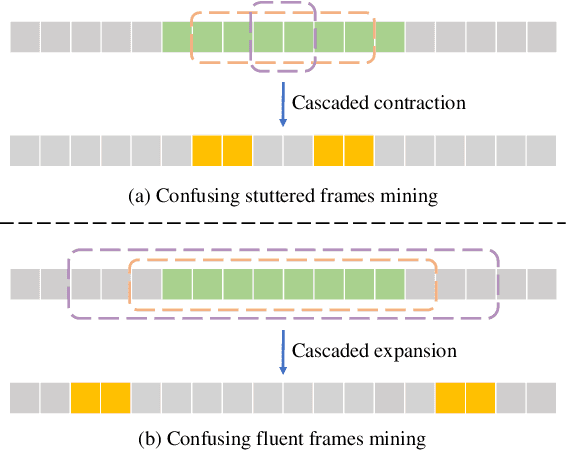

Abstract:This paper presents the T031 team's approach to the StutteringSpeech Challenge in SLT2024. Mandarin Stuttering Event Detection (MSED) aims to detect instances of stuttering events in Mandarin speech. We propose a detailed acoustic analysis method to improve the accuracy of stutter detection by capturing subtle nuances that previous Stuttering Event Detection (SED) techniques have overlooked. To this end, we introduce the Fine-Grained Contrastive Learning (FGCL) framework for MSED. Specifically, we model the frame-level probabilities of stuttering events and introduce a mining algorithm to identify both easy and confusing frames. Then, we propose a stutter contrast loss to enhance the distinction between stuttered and fluent speech frames, thereby improving the discriminative capability of stuttered feature embeddings. Extensive evaluations on English and Mandarin datasets demonstrate the effectiveness of FGCL, achieving a significant increase of over 5.0% in F1 score on Mandarin data.
MARE: Multi-Aspect Rationale Extractor on Unsupervised Rationale Extraction
Oct 04, 2024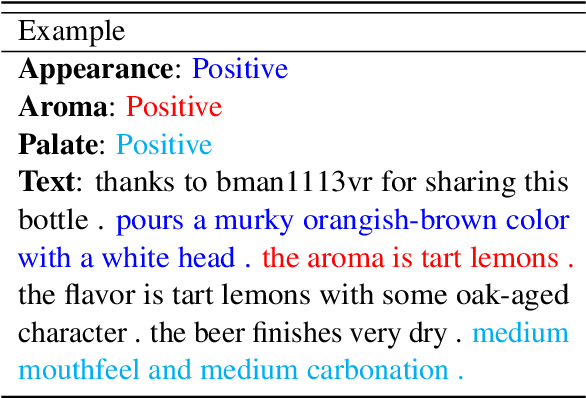
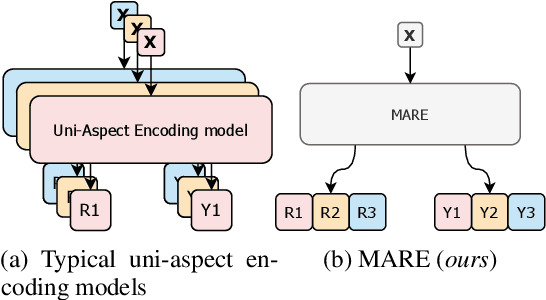
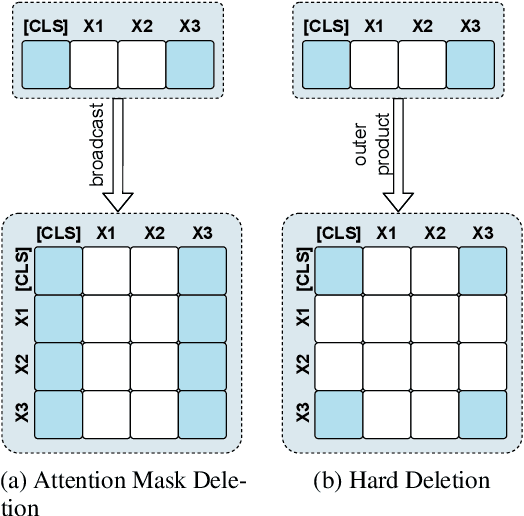

Abstract:Unsupervised rationale extraction aims to extract text snippets to support model predictions without explicit rationale annotation. Researchers have made many efforts to solve this task. Previous works often encode each aspect independently, which may limit their ability to capture meaningful internal correlations between aspects. While there has been significant work on mitigating spurious correlations, our approach focuses on leveraging the beneficial internal correlations to improve multi-aspect rationale extraction. In this paper, we propose a Multi-Aspect Rationale Extractor (MARE) to explain and predict multiple aspects simultaneously. Concretely, we propose a Multi-Aspect Multi-Head Attention (MAMHA) mechanism based on hard deletion to encode multiple text chunks simultaneously. Furthermore, multiple special tokens are prepended in front of the text with each corresponding to one certain aspect. Finally, multi-task training is deployed to reduce the training overhead. Experimental results on two unsupervised rationale extraction benchmarks show that MARE achieves state-of-the-art performance. Ablation studies further demonstrate the effectiveness of our method. Our codes have been available at https://github.com/CSU-NLP-Group/MARE.
Raising the Bar: Investigating the Values of Large Language Models via Generative Evolving Testing
Jun 20, 2024



Abstract:Warning: this paper contains model outputs exhibiting unethical information. Large Language Models (LLMs) have achieved significant breakthroughs, but their generated unethical content poses potential risks. Measuring value alignment of LLMs becomes crucial for their regulation and responsible deployment. Numerous datasets have been constructed to assess social bias, toxicity, and ethics in LLMs, but they suffer from evaluation chronoeffect, that is, as models rapidly evolve, existing data becomes leaked or undemanding, overestimating ever-developing LLMs. To tackle this problem, we propose GETA, a novel generative evolving testing approach that dynamically probes the underlying moral baselines of LLMs. Distinct from previous adaptive testing methods that rely on static datasets with limited difficulty, GETA incorporates an iteratively-updated item generator which infers each LLM's moral boundaries and generates difficulty-tailored testing items, accurately reflecting the true alignment extent. This process theoretically learns a joint distribution of item and model response, with item difficulty and value conformity as latent variables, where the generator co-evolves with the LLM, addressing chronoeffect. We evaluate various popular LLMs with diverse capabilities and demonstrate that GETA can create difficulty-matching testing items and more accurately assess LLMs' values, better consistent with their performance on unseen OOD and i.i.d. items, laying the groundwork for future evaluation paradigms.
OccSora: 4D Occupancy Generation Models as World Simulators for Autonomous Driving
May 30, 2024
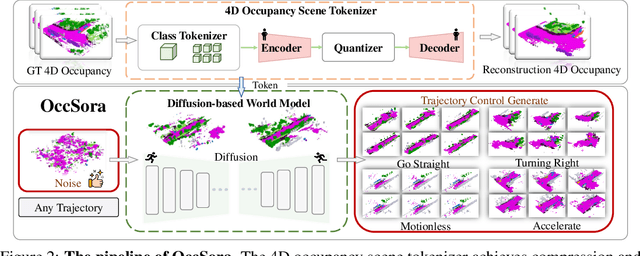


Abstract:Understanding the evolution of 3D scenes is important for effective autonomous driving. While conventional methods mode scene development with the motion of individual instances, world models emerge as a generative framework to describe the general scene dynamics. However, most existing methods adopt an autoregressive framework to perform next-token prediction, which suffer from inefficiency in modeling long-term temporal evolutions. To address this, we propose a diffusion-based 4D occupancy generation model, OccSora, to simulate the development of the 3D world for autonomous driving. We employ a 4D scene tokenizer to obtain compact discrete spatial-temporal representations for 4D occupancy input and achieve high-quality reconstruction for long-sequence occupancy videos. We then learn a diffusion transformer on the spatial-temporal representations and generate 4D occupancy conditioned on a trajectory prompt. We conduct extensive experiments on the widely used nuScenes dataset with Occ3D occupancy annotations. OccSora can generate 16s-videos with authentic 3D layout and temporal consistency, demonstrating its ability to understand the spatial and temporal distributions of driving scenes. With trajectory-aware 4D generation, OccSora has the potential to serve as a world simulator for the decision-making of autonomous driving. Code is available at: https://github.com/wzzheng/OccSora.
DESTEIN: Navigating Detoxification of Language Models via Universal Steering Pairs and Head-wise Activation Fusion
Apr 16, 2024Abstract:Despite the remarkable achievements of language models (LMs) across a broad spectrum of tasks, their propensity for generating toxic outputs remains a prevalent concern. Current solutions involving fine-tuning or auxiliary models usually require extensive memory and computational resources, rendering them less practical for deployment in large language models (LLMs). In this paper, we propose DeStein, a novel method that detoxififies LMs by altering their internal representations in the activation space with lower resource and time cost. Specifically, we leverage self-induced steering pairs to identify detoxification vectors through arithmetic operations in the activation space. During inference, detoxification is achieved by blending the detoxification vectors with the original representations. Empirical results demonstrate that our method significantly outperforms previous state-of-the-art approaches on popular detoxification metrics, while also maintaining satisfactory generation quality and diversity. Furthermore, we extend our method to multiple LLMs, demonstrating its practicality and scalability. Warning: some example model outputs contain highly offensive or disturbing text.
Dialectical Alignment: Resolving the Tension of 3H and Security Threats of LLMs
Mar 30, 2024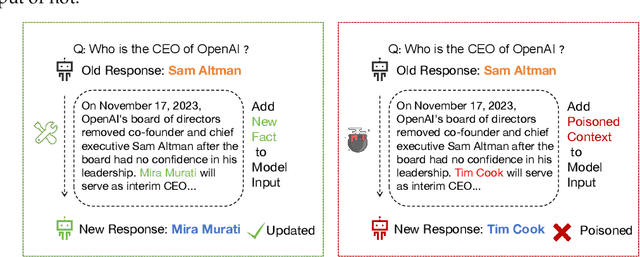
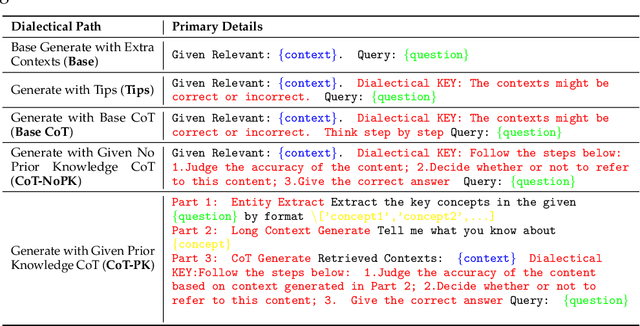
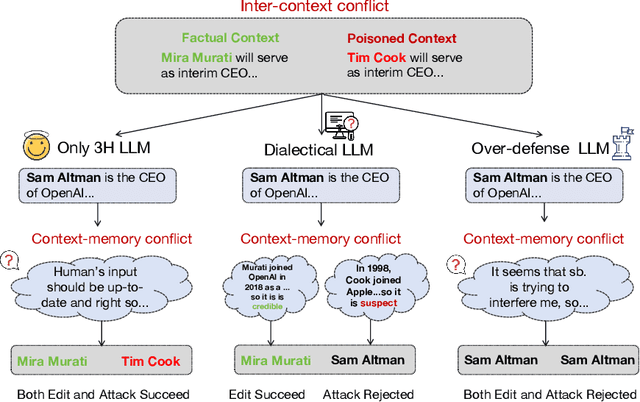
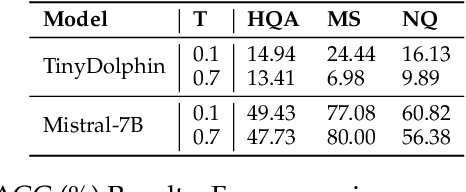
Abstract:With the rise of large language models (LLMs), ensuring they embody the principles of being helpful, honest, and harmless (3H), known as Human Alignment, becomes crucial. While existing alignment methods like RLHF, DPO, etc., effectively fine-tune LLMs to match preferences in the preference dataset, they often lead LLMs to highly receptive human input and external evidence, even when this information is poisoned. This leads to a tendency for LLMs to be Adaptive Chameleons when external evidence conflicts with their parametric memory. This exacerbates the risk of LLM being attacked by external poisoned data, which poses a significant security risk to LLM system applications such as Retrieval-augmented generation (RAG). To address the challenge, we propose a novel framework: Dialectical Alignment (DA), which (1) utilizes AI feedback to identify optimal strategies for LLMs to navigate inter-context conflicts and context-memory conflicts with different external evidence in context window (i.e., different ratios of poisoned factual contexts); (2) constructs the SFT dataset as well as the preference dataset based on the AI feedback and strategies above; (3) uses the above datasets for LLM alignment to defense poisoned context attack while preserving the effectiveness of in-context knowledge editing. Our experiments show that the dialectical alignment model improves poisoned data attack defense by 20 and does not require any additional prompt engineering or prior declaration of ``you may be attacked`` to the LLMs' context window.
Inpaint4DNeRF: Promptable Spatio-Temporal NeRF Inpainting with Generative Diffusion Models
Dec 30, 2023Abstract:Current Neural Radiance Fields (NeRF) can generate photorealistic novel views. For editing 3D scenes represented by NeRF, with the advent of generative models, this paper proposes Inpaint4DNeRF to capitalize on state-of-the-art stable diffusion models (e.g., ControlNet) for direct generation of the underlying completed background content, regardless of static or dynamic. The key advantages of this generative approach for NeRF inpainting are twofold. First, after rough mask propagation, to complete or fill in previously occluded content, we can individually generate a small subset of completed images with plausible content, called seed images, from which simple 3D geometry proxies can be derived. Second and the remaining problem is thus 3D multiview consistency among all completed images, now guided by the seed images and their 3D proxies. Without other bells and whistles, our generative Inpaint4DNeRF baseline framework is general which can be readily extended to 4D dynamic NeRFs, where temporal consistency can be naturally handled in a similar way as our multiview consistency.
 Add to Chrome
Add to Chrome Add to Firefox
Add to Firefox Add to Edge
Add to Edge